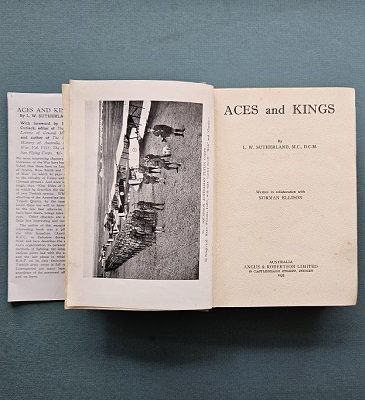Description
Title: Aces and Kings, No 1 Squadron
Author: Sutherland, Leslie William MC, DCM
Condition: Very Good Plus – Facsimilie dust jacket, minor foxing and damage to rear book hinge as per picture.
Edition: 1st Edition
Publication Date: 1935
Cover: Hard Cover without Dust Jacket – 276 pages
Comments: The history of the No 1 Squadron, Australian Flying Corps.
This unusual and interesting memoir, as its foreword by the official historian of the Australian Flying Corps makes clear aims to present the human side of one theatre of the Great War in the air: that of the last crusade to free Palestine from Ottoman Turkish rule.
The author, L.W. Sutherland, was an officer in No. 1 Squadron of the AFC, piloting a succession of aircraft – SE5s, RE8s, DH6s, Nieuport Scouts and Bristol Fighters – through the desert skies. Sutherlands down to earth memoir certainly succeeds in conveying the rough, tough Aussie humour with which he and his comrades confronted the hardships around them. But he never lets the reader forget that war is always a grim business, as the title of one of his last chapters on the final Turkish rout -Nine Miles of Dead cogently conveys.
Among other curiosities the book also contains one interesting and admiring chapter on T.E. Lawrence and his controversial contribution to the campaign. For Sutherland at least, who often acted as a courier and air chauffeur to Lawrence’s irregulars,
TEL remains an unstained hero. The book is illustrated with some fine photos of planes, pilots and Arab fighters.
Following an invitation from Britain to the dominions to form complete flying squadrons for service with the British forces, the first squadron of the Australian Flying Corps (AFC) was formed at Point Cook in Victoria in January 1916. It sailed from Melbourne on 16 March, and arrived in Egypt on 14 April. The squadron’s less experienced pilots were sent to the United Kingdom for further training, while other personnel were attached to the Royal Flying Corps to further hone their skills. Upon joining the British forces in Egypt the squadron became known as 67 (Australian) Squadron, Royal Flying Corps (RFC), and would not revert to its original name until 19 January 1918.
The squadron began flying operations in its own right on 12 June 1916, although its three flights operated independently from dispersed airfields. Initially the squadron’s main role was aerial reconnaissance and its aircraft operated both out across the Sinai desert in search of Turkish forces, and across Egypt’s western desert to monitor activity by the rebellious Senussi. Increasingly, though, its aircraft were involved in attacks against Turkish ground forces.
After being reunited in December 1916, the squadron supported the British and dominion advance into Palestine. It became a “jack of all trades” carrying out reconnaissance, photography, ground attack and liaison missions, in addition to having to fight off aggressive German adversaries. For his actions following an attack on the railway line at Tel el Hesi, near Gaza, on 20 March 1917, Lieutenant Frank MacNamara was awarded the Victoria Cross. During the raid one of McNamara’s comrades was forced down and, despite being wounded himself, McNamara landed to rescue him from beneath the guns of a Turkish cavalry unit.
With the arrival of new aircraft in the second half of 1917, the British and dominion air forces were able to gradually wrest control of the air from the German squadrons. This allowed them to range over Turkish territory with virtual impunity and air power contributed greatly to the success of British and dominion operations in 1918, particularly the last great offensive of the campaign, launched with the Battle of Megiddo on 19 September 1918. The Turkish forces surrendered on 31 October. Addressing the squadron after the Armistice, General Sir Edmund Allenby, the British Commander-in-Chief, congratulated it for its role in the victory:
This squadron played an important part in making this achievement possible. You gained for us absolute supremacy of the air, thereby enabling my cavalry, artillery and infantry to carry out their work on the ground practically unmolested by hostile aircraft. This undoubtedly was a factor of paramount importance in the success of our arms here.
1 Squadron returned to Egypt in February 1919, embarked for home on 5 March, and was disbanded upon its arrival in Australia.






